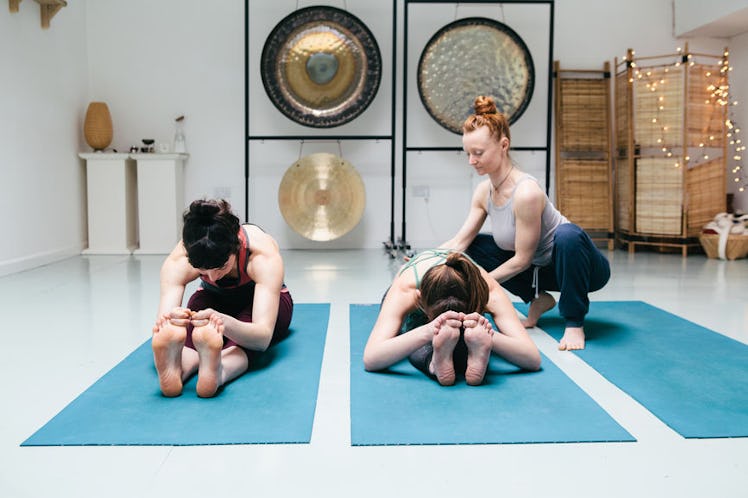
Here's Why You Don't HAVE To Do What The Teacher Says In Yoga Class, According To Real Yogis
My yoga practice used to hurt my body way more than it helped. I would push past obvious discomfort and unpleasant sensations just for the sake of getting deeper into the asanas to prove something to myself, and because, well, it is a workout, right? No pain, no gain? Well, while it's true that yoga can be a great physical form of exercise, my former approach to my practice wasn't actually doing my body or my mind any favors. Learning how to listen to your body in yoga class, on the other hand, is, I've come to learn, one of the most sacred things about the practice overall — even if that means skipping all of the "cool" poses your teacher is cueing in class, and staying in child's pose the entire time, instead.
According to Susan Shumsky, a yoga teacher and author of the book Awaken Your Divine Intuition, your time in yoga class should never be a physical endurance test or competition. "It’s not a good idea to compare yourself to other people or to try to be the 'best in class' at doing an asana or other yogic practice," Shumsky tells Elite Daily ove email. "The idea of competition is entirely antithetical to the concept of yoga."
Personally, it took me years to come to this realization. But now, my practice feels better than ever, all because I learned to look at my time on the mat as an opportunity to do something good and constructive for no one other than myself.
Of course, it's easier said than done to focus only on yourself and your own progress when you're in a yoga class, surrounded by dozens of other people contorting themselves into impressive shapes and poses. However, according to Shumsky, when engaging in your yoga practice, it's crucial to pay attention to your body, not anyone else's. "Do not strain or try to outdo yourself or other people," she explains. "You can be injured by attempting physical feats without slowly and gradually building up to them."
Ultimately, yoga is about listening to what your body is telling you; more specifically, the practice entails tuning into what is best for your individual body at that exact moment in time. In other words, just because you could hold pigeon pose in your yoga class without feeling strained last week, that doesn't necessarily mean you should feel defeated or frustrated just because the pose doesn't feel natural in the present moment. Our bodies change every single day, and what you did in class last week, or even last month, could be the exact opposite of what serves you best now.
What's arguably even more important (and what many beginner yogis don't realize right away) is that you don't have to listen to every single thing your teacher says in a yoga class — especially if the poses don't feel right for you. "If a yoga teacher is guiding the class to do something that you don’t feel like doing, the world will not come to an end if you instead just lie down and enjoy savasana," Shumsky tells Elite Daily.
Any good yoga teacher will completely respect your decision to do your own thing as the rest of the class continues flowing, because in truth, doing so is really an act of unconditional self-care. As a woman who's practiced yoga for the last 18 years of her life, Sara DiVello, a nationally recognized yoga and meditation teacher and bestselling author of the book Where in the OM Am I?, says it’s fundamental to the overall practice to listen to your body, "because nobody knows your body better than you," she tells Elite Daily in an email. "YOU know what feels good. You know when you’ve reached your limit. You know when to do more. And you know when to rest," DiVello explains.
Ignoring your body's own cues in favor of the teacher's instructions — or even a passing thought of what you worry you "should" be doing — is the quickest way to get injured, according to Divello. "I have stayed in child’s pose — or even come into supported savasana — when I needed to, and I always encourage my students to do the same," the yoga teacher explains. "In fact, I’ve stayed in savasana even after the class ended and had a good cry, and felt about 100 times better afterward."
Divello tells me her personal mantra is this: your body, your practice, your choice — always. I am so here for that, guys. But what does that actually look like IRL, and how can you go about listening to your body's cues more closely in your yoga classes?
Picture it going something like this, says DiVello: "You’re in a pose and finally reach that place of stillness and connection — you know you need to stay. The teacher keeps teaching, calling out for the next pose, and the rest of the class follows, but you just... stay as you are and don’t worry about what everyone else is doing because you are on your own journey," the yoga teacher explains.
It all boils down to being mindful and in-tune with your individual needs. I personally suffered quite a few yoga-induced injuries before realizing that, some days, my body's just craving a whole lot of savasana, meditation, rest, and nothing else — and that's OK. "Understand that there are many paths to yoga," Shumsky says, "and the physical path is just one." It's up to you to find out which other paths are right for you.